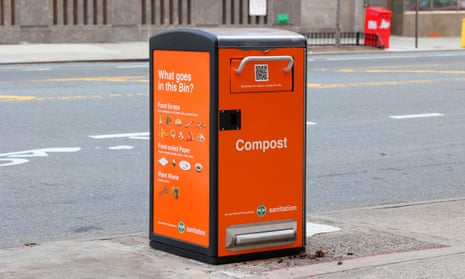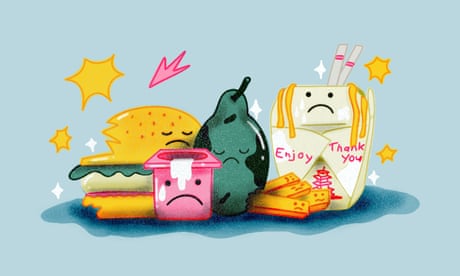The scraps in your bin marked ‘compost’ may end up as methane. Here’s what that means

A smart compost bin in Manhattan. The contents go to an anaerobic digester at a wastewater treatment plant.
Photograph: Robert K Chin/Alamy
Wed 30 Aug 2023
When orange bins marked for “compost” drop-off first started proliferating on the streets of New York in February as part of a department of sanitation pilot, many residents celebrated. I was one of them: even as an environmental reporter who has visited the landfill where my trash ends up and is well aware of the problems with food waste, the lack of convenient composting options near me was often prohibitive. Having a bin within walking distance I could access at any time meant all my food waste would finally be converted back into soil.

How to reduce food waste at home: separate your apples and repurpose your leftovers
Or at least that’s what I thought it meant, until the news broke in April that the contents of those “compost” bins mostly don’t go to compost sites, but to an anaerobic digester at a wastewater treatment plant called Newtown Creek. There, the food waste is mixed into sewage before being converted partially into methane.
I wasn’t sure what to make of this, and neither were my neighbors, given that methane is a potent greenhouse gas playing a role in the climate crisis.
Questions about anaerobic digestion – touted as a green solution to food waste – are becoming relevant in more and more places as this method is increasingly a part of organic waste management plans across the US, with plants operating or being built everywhere from Ohio to California and embraced by brands such as Ben & Jerry’s. It’s also fairly common in parts of Europe. But how do its environmental credentials stack up against composting?
The pros and cons of anaerobic digestion
Both composting and anaerobic digestion, or AD, use microorganisms to break down food waste. Composting does so in the presence of oxygen, and creates (you guessed it) compost; AD does so without oxygen and produces solid and liquid organic leftover matter called digestate – and methane.
When anaerobic digestion is at its most climate-friendly, that methane is captured and used for what Dr Stephanie Lansing, a professor of environmental science and technology at the University of Maryland, calls renewable energy, while the solids left over after the AD process are cured and turned into compost. From Lansing’s perspective, these options make AD the clear winner over composting.
“Why would you not want to get the renewable energy first, and then get the compost later, because you still get both resources when you do digestion?” she asked.
But whether or not AD actually comes with those promised environmental benefits depends on how an anaerobic digestion facility is run, which can vary greatly. Though the methane can be turned into energy to power houses or waste facilities themselves, many still flare (burn and release into the atmosphere) some of the methane they generate. (The plant nearest me, Newtown Creek, was flaring half of its methane up until this April.)
Generating garbage is not something we want to be doing at all, so that’s not something that we should be thinking of as renewableDarby Hoover of the National Resources Defense Council
And even when all the gas from a digester is being captured and used for energy, not everyone is comfortable describing it as “renewable energy”. According to Darby Hoover, a senior resource specialist at the National Resources Defense Council (NRDC), “‘renewable’ implies a resource that can be replenished. And for me, it implies that it can be replenished with little ecological cost. But generating garbage is not something we want to be doing at all, so that’s not something that we should be thinking of as renewable.”
The NRDC isn’t anti-anaerobic digestion, and it “sometimes supports the inclusion of anaerobic digestion biogas in renewable energy portfolios”, but in a “limited” way, Hoover added. A recent report published by the non-profit instead recommended prioritizing surplus food rescue, food waste prevention and compost over sending food waste directly to anaerobic digesters.
Another recommendation the NRDC makes – that the solids left over at the end of anaerobic digestion be turned into compost and added to soil – is a good practice, and one that AD proponents often highlight. But in reality, the practice is underutilized: more than half of all biosolids in the US are landfilled or incinerated rather than composted. When anaerobic digesters process food waste and sewage sludge at the same time, rather than processing food waste on its own, the end result can contain toxins that render the digestate unfit for adding to dirt that people are in close contact with, ie garden or public park soils.
“The takeaway is not ‘you should never do anaerobic digestion,’” said Hoover. “But it is ‘you should really think through a lot of different components before you launch into using anaerobic digestion for food waste in particular.’”
The case for composting
Many people are familiar with the basic argument for composting: it reduces food waste and the associated greenhouse gases, and leaves behind an end product that supports healthy soils.
But according to Dior St Hillaire, co-director of composting non-profit BK Rot and chair of the Bronx Solid Waste Advisory Board, the benefits go much deeper.
Composting can create local green jobs, build community and generate crucial buy-in, so people are more motivated to separate out their food and yard waste rather than throwing it in the trash.
“That connection is lost when you’re thinking about anaerobic digestion,” she said. “You already see low numbers of recycling because people are not connected to it; they don’t believe it’s happening or believe in the viability of it. So imagine what [organics separation] is going to look like when you have people who are not connected to that end result. I think you’ll find really low participation rates.”
Keeping nutrients cycling locally through compost rather than trucking waste off to a digester also promotes climate resilience. According to Clare Miflin, executive director of the Center for Zero Waste Design, adding compost to soil boosts the health of the trees and greenery that help cities combat dangerous heat. Plus, healthy soils amended with compost absorb up to “six times more rainwater”, protecting the city against floods.
A side-by-side comparison
When weighing the benefits of composting and anaerobic digestion, not everyone agrees on which should come out on top. The US Environmental Protection Agency (EPA) prioritizes anaerobic digestion above composting in its food recovery hierarchy; meanwhile, the NRDC places the two options on the same tier and says the best option depends on the scenario.
In New York City, anaerobic digestion looks likely to continue expanding, and financial incentives are almost certainly playing a role. Wastewater treatment plants with digesters receive a “tipping fee” from garbage collectors for accepting food waste, according to the EPA, and facilities that scrub their methane to pipeline quality can sell it as “renewable fuel”, at which point they’re “guaranteed a nice rate by federal law”, said Lansing.
Hoover, of the NRDC, doesn’t think that AD being part of a city’s mix of waste management strategies is necessarily a bad thing. It just means cities and their citizens need to weigh the specifics of any proposed composting or anaerobic digestion system, and demand that it’s held to the highest standards.
Along the way, city agencies need to be transparent if they want citizens to actively participate in the waste sorting necessary to make any of these solutions work. Slapping “compost” on the side of a street corner bin might convince citizens to dump their banana peels there, but if people find out later that those bins don’t actually go to compost, it could break trust and lead to composting being regarded with the suspicion currently reserved for recycling.
“We don’t want to keep sending more messages that it’s OK to say we’re doing one thing, and we’re actually doing another,” said St Hillaire.

The apps fighting food waste by saving restaurant meals from the trash
Luckily, there are a few things everyone seems to agree on. First, certain kinds of waste are better handled by one system or the other: anaerobic digestion can accept dairy, meat and grease that compost sites can’t, while compost is better able to break down paper goods. And even more important, both options offer significant climate benefits. According to a report from the National Renewable Energy Lab, anaerobic digestion and composting have comparable emissions footprints when the AD digestate is applied to soil rather than landfilled.
From the perspective of many environmental advocates, the best solution will involve some mix of the two solutions, blending the efficiency and financial incentives of AD with the community and ecosystem benefits of composting.
“It’s not that AD trumps all or compost trumps all,” said St Hillaire. “New York City is a big city with a very dense population, we need as many [solutions] as possible.”
In other words, both anaerobic digestion and composting are far better options than landfilling, so keep separating out your organics rather than throwing them in the trash. I know I will.

No comments:
Post a Comment